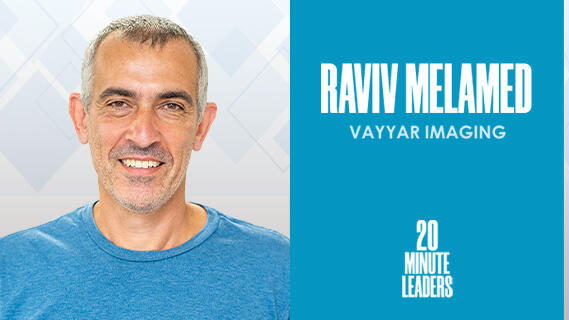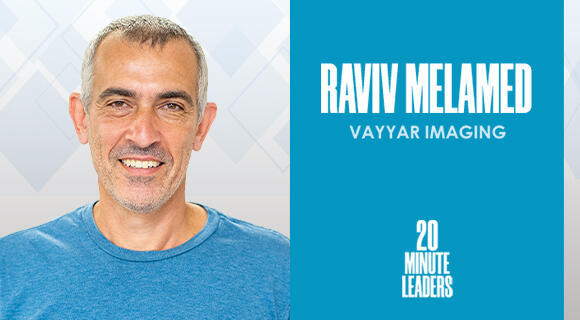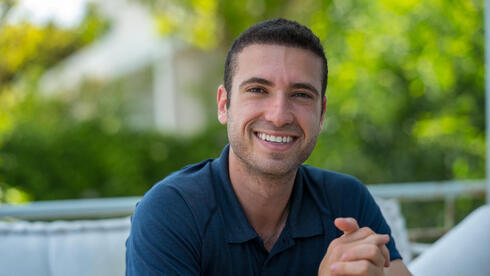
20-Minute Leaders
“Moving into new markets requires the ability to give people freedom to really take risks.”
Allowing employees the freedom and support to take big risks is necessary to move into new markets, says Raviv Melamed, CEO of Vayyar Imaging.
Allowing employees the freedom and support to take big risks is necessary to move into new markets, says Raviv Melamed, CEO of Vayyar Imaging. It’s a lesson he learned from his time at Intel and is executing at Vayyar, which uses 4D radar imaging in a variety of scenarios. After Intel, he wanted to try a new industry, and he thought he could make a difference in the medical field. Melamed explains that bringing technologies from a different market can bring great innovation, and that’s exactly what he did with Vayyar. He had looked into walls with radio waves in the army and figured out how to bring similar technology to medical imaging as well as other verticals. The company started off pursuing four applications and has added more since they began. Melamed says they aim to fail fast and not invest too much in ideas that don’t work out.
Click Here For More 20MinuteLeaders
Tell me a little bit about yourself, Raviv. Who are you?
It's a short question and a long answer, but I still need to find out so I can't tell you that yet. I started my life as an engineer when I was 13, building different things in electronics and trying to sell them. Then in the army, I was doing more complex systems. Then I went to a startup, and that startup that was acquired by Intel. Then I developed myself in Intel to become VP and GM of the wireless group there. Then another startup called Vayyar.
Tell me about what you learned from Intel going into Vayyar.
I learned a lot, especially about how big organizations work and what happens to an organization at the later stage of its life. You form a way of thinking and bureaucracy that can't really move fast and basically misses things sometimes. Intel is a great company. They do great things. But trying to go into new markets requires different sets of capabilities and the ability to give freedom to people to go and take it all the way through. Not just throwing money at it, just really taking a real risk. I'm really thankful for Intel allowing me to do that.
Take me back 11 years ago. You are about to embark on a new journey in 4D radar imagery. What is the problem that you are observing in the world?
Once I decided to leave Intel, I started to think about what I want to do and I started to look at the market. The market that was interesting for me was the medical market because that was something that I didn't do before. I thought that I'll be able to do good things with my knowledge.
One of the things I learned over time is that when you want to really create innovation in certain markets, you can bring technologies from a different market to that market and suddenly good things happen. That's kind of what happened over here. I was asking myself, “Why can't I use radio wave frequencies to look into the human body?” That was based on something that I did in the past in the army that looked into walls with the radio waves. I found out that in the past they all got to the same kind of issue, which was the cost of the systems.
At that time, MIMO radar, basically, just started. Then silicon was just starting to become very cheap for RF. I said, "Hey, if you come with silicon concepts to this problem, then you can actually create imaging." That was the moment I was like, "We have something here. Now, let's see what we can do with it.” Breast cancer imaging was the right market for that to start with.
When you are imagining the world with this technology, what can we do potentially? Why is this interesting?
We started with breast cancer imaging. But we quickly understood that the same sensor can be used in multiple markets. That's what we do today. The moment you have a sensor that can see through things with high resolution, that can see in every environmental condition, and it's very low cost, then there's multiple applications. Looking inside walls, looking inside the human body, tracking people, tracking objects, et cetera.
We pitched four applications because it's not an easy thing to do medical. It was very unusual at that time. Today, people are more open to it. We started in parallel in-wall imaging, testing, breast cancer imaging, and also imaging in mass production of food to detect contaminants. Since then, we added several more applications, like automotive and elderly care.
You took from the corporate world the idea of autonomy and really supporting new verticals or new domains within organizations. Is that what we are seeing here? How do you as the CEO make that a reality?
First of all, it starts with the structure of the organization. We've created an organization that is self-contained that can bring innovation, but that innovation is market-driven. We are trying to solve the next problems. Think about it as a filter. If BD says, "That's the market," then we come and talk to the customers, and we are doing proof of concepts in that organization. They are cleaning up the stuff that doesn't work and leaving the ones that work. There is a customer in the market behind it. We know we are vetting this and moving it into the R&D stage and then developing that new market. It's moving very, very fast and we fail fast. That's super important. Those POCs allow us to do something; if it doesn't work, throw it away. We don't invest too much time and effort in it. This is exactly how automotive and elderly care started in Vayyar.
Are those verticals entering bottom-up or top-down? Who is the champion of these new verticals that are coming into Vayyar?
It can be bottom-up or top-down. It doesn't really matter. This morning, one of our employees told me, "I have a new idea for Vayyar." The first step of his idea is to go and check it out in the market. The BD guys will go and check it. If there is a customer paying for a POC, that will go to the next step. If the customer applies for a project, that's probably going to go to the end of the road. It doesn't matter who brings the idea. If it's a good idea, it will survive.
Tell me about different interesting use cases for Vayyar in the real world.
Elderly care is a simple example. Today there's so many old people in their homes and you have no clue what's going on. There's a very interesting psychological element here. For example, you have parents, probably around 60. And you think that your parents will live forever, right?
Of course they will.
That's how your mind is thinking. Your brain refuses to understand the fact that they are actually getting older, getting weaker, etc. And they always look at you as their son and they don't want you to know what's going on with them. At a certain age, they are starting to fall, but they are not going to tell you. Then comes the big fall, a fall that they cannot hide anymore. Then you start to really, really be worried about them.
You need to find a balance where you know that they are okay, but you still keep their dignity. You are not going to put cameras in your parents' bedroom or bathroom. But you will put a sensor that keeps their privacy but monitors them in a way that if there is a fall, you will know about it. That's the first step. The second step, preventive medicine, is even more interesting. Preventive medicine means that you track a person over time and compare data. If you have a sensor in the home that keeps privacy from one hand, no pictures, no something that tells anybody that that's me, but I still get the data and I can analyze an alert, then super important.
Two examples: In an elderly care facility where we are tracking a person, we found out that he is sitting on the sofa more and more. The medical team was alerted. They checked the guy and they found out that he has heart issues. Another case was with a woman that lost her husband. The device basically alerted them that she was staying in bed longer and longer. Basically, she was kind of getting into depression. Again, send the medical team. That's going to change people's lives dramatically.
Michael Matias, Forbes 30 Under 30, is a Venture Fellow at Innovation Endeavors as well as investment Venture Partner at Secret Chord and J-Ventures. He studies Artificial Intelligence and Human-Computer Interaction at Stanford University, and was an engineer at Hippo Insurance. Matias previously served as an officer in the 8200 unit. 20MinuteLeaders is a tech entrepreneurship interview series featuring one-on-one interviews with fascinating founders, innovators and thought leaders sharing their journeys and experiences.
Contributing editors: Michael Matias, Megan Ryan

